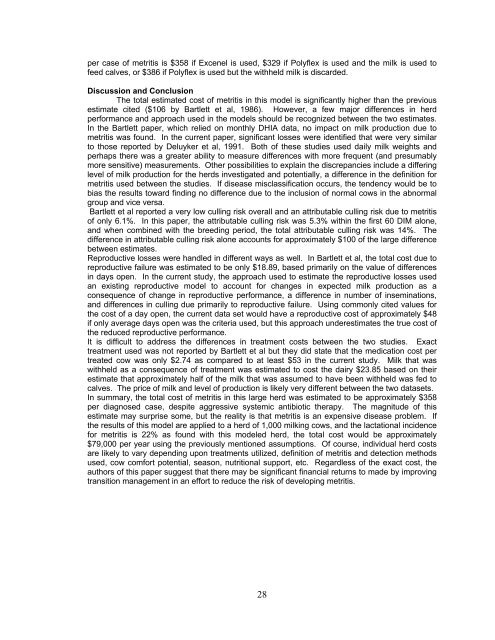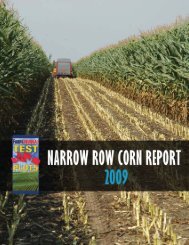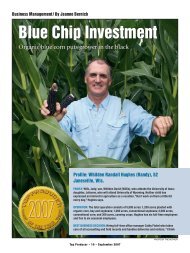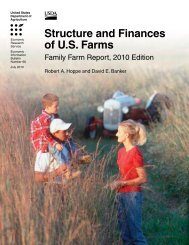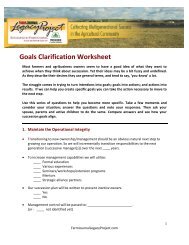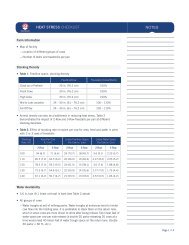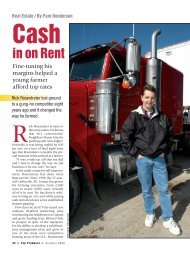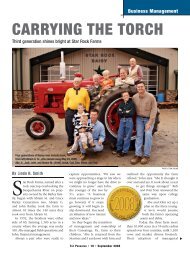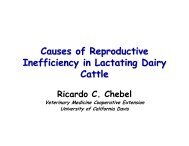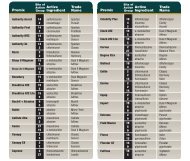24 Economics of Postpartum Uterine Health - AgWeb
24 Economics of Postpartum Uterine Health - AgWeb
24 Economics of Postpartum Uterine Health - AgWeb
Create successful ePaper yourself
Turn your PDF publications into a flip-book with our unique Google optimized e-Paper software.
per case <strong>of</strong> metritis is $358 if Excenel is used, $329 if Polyflex is used and the milk is used t<strong>of</strong>eed calves, or $386 if Polyflex is used but the withheld milk is discarded.Discussion and ConclusionThe total estimated cost <strong>of</strong> metritis in this model is significantly higher than the previousestimate cited ($106 by Bartlett et al, 1986). However, a few major differences in herdperformance and approach used in the models should be recognized between the two estimates.In the Bartlett paper, which relied on monthly DHIA data, no impact on milk production due tometritis was found. In the current paper, significant losses were identified that were very similarto those reported by Deluyker et al, 1991. Both <strong>of</strong> these studies used daily milk weights andperhaps there was a greater ability to measure differences with more frequent (and presumablymore sensitive) measurements. Other possibilities to explain the discrepancies include a differinglevel <strong>of</strong> milk production for the herds investigated and potentially, a difference in the definition formetritis used between the studies. If disease misclassification occurs, the tendency would be tobias the results toward finding no difference due to the inclusion <strong>of</strong> normal cows in the abnormalgroup and vice versa.Bartlett et al reported a very low culling risk overall and an attributable culling risk due to metritis<strong>of</strong> only 6.1%. In this paper, the attributable culling risk was 5.3% within the first 60 DIM alone,and when combined with the breeding period, the total attributable culling risk was 14%. Thedifference in attributable culling risk alone accounts for approximately $100 <strong>of</strong> the large differencebetween estimates.Reproductive losses were handled in different ways as well. In Bartlett et al, the total cost due toreproductive failure was estimated to be only $18.89, based primarily on the value <strong>of</strong> differencesin days open. In the current study, the approach used to estimate the reproductive losses usedan existing reproductive model to account for changes in expected milk production as aconsequence <strong>of</strong> change in reproductive performance, a difference in number <strong>of</strong> inseminations,and differences in culling due primarily to reproductive failure. Using commonly cited values forthe cost <strong>of</strong> a day open, the current data set would have a reproductive cost <strong>of</strong> approximately $48if only average days open was the criteria used, but this approach underestimates the true cost <strong>of</strong>the reduced reproductive performance.It is difficult to address the differences in treatment costs between the two studies. Exacttreatment used was not reported by Bartlett et al but they did state that the medication cost pertreated cow was only $2.74 as compared to at least $53 in the current study. Milk that waswithheld as a consequence <strong>of</strong> treatment was estimated to cost the dairy $23.85 based on theirestimate that approximately half <strong>of</strong> the milk that was assumed to have been withheld was fed tocalves. The price <strong>of</strong> milk and level <strong>of</strong> production is likely very different between the two datasets.In summary, the total cost <strong>of</strong> metritis in this large herd was estimated to be approximately $358per diagnosed case, despite aggressive systemic antibiotic therapy. The magnitude <strong>of</strong> thisestimate may surprise some, but the reality is that metritis is an expensive disease problem. Ifthe results <strong>of</strong> this model are applied to a herd <strong>of</strong> 1,000 milking cows, and the lactational incidencefor metritis is 22% as found with this modeled herd, the total cost would be approximately$79,000 per year using the previously mentioned assumptions. Of course, individual herd costsare likely to vary depending upon treatments utilized, definition <strong>of</strong> metritis and detection methodsused, cow comfort potential, season, nutritional support, etc. Regardless <strong>of</strong> the exact cost, theauthors <strong>of</strong> this paper suggest that there may be significant financial returns to made by improvingtransition management in an effort to reduce the risk <strong>of</strong> developing metritis.28


